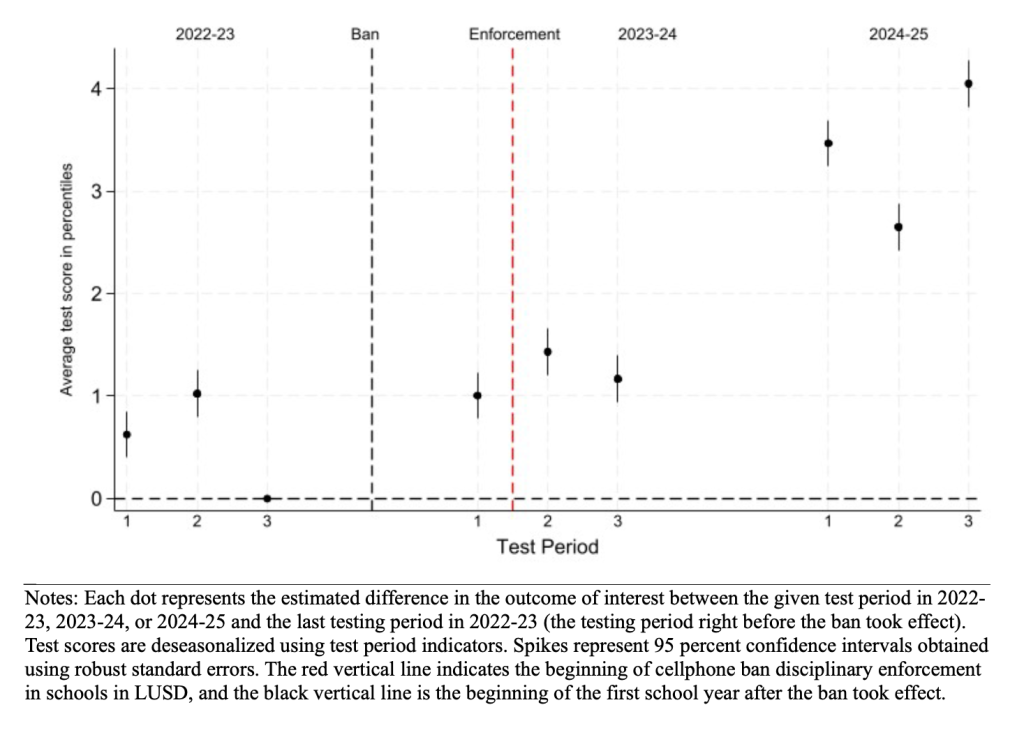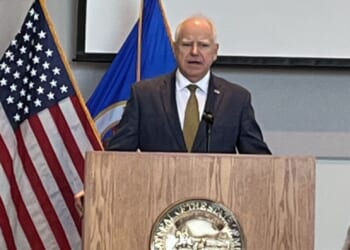As cellphone restrictions in U.S. schools — and globally — continue to grow popular and increasingly become go-to legislation in the education reform sphere, the obvious next question is whether or not such policy actually works in improving academic achievement, curbing attention issues, and improving overall student well-being.
A recent study on Florida’s statewide cellphone restriction policy found encouraging results — schools significantly improved student attendance (especially pertaining to unexcused absences) in the first and second year of the ban and significantly improved student test scores in the second year of the ban, particularly in middle and high school settings where cellphone ownership is more common.
Florida’s policy, which began in 2023, forbids K-12 students from using cellphones during instructional time. It is the first state that implemented a statewide cellphone policy.
Researchers David Figlio and Umut Özek point out that Florida’s cellphone ban differs from bans in other states in several ways, taking a more comprehensive approach to protecting instructional time and ensuring the safety of students while accessing the internet at school.
For one, school districts are required to provide and adopt an internet safety policy for when they provide student access to the internet. School districts are also required to prohibit and prevent students from accessing social media platforms through district-provided internet access (unless directed by a teacher solely for educational purposes). Use of the TikTok platform is prohibited across the board, and students in grades 6 through 12 are required to receive instruction on the social, emotional, and physical effects of social media, including its negative effects on mental health, its distribution of misinformation, how it manipulates behavior, the permanency of material shared online, and how to maintain personal security and identify cyberbullying, predatory behavior, and human trafficking.
In the second year of the policy’s implementation, standardized test scores improved significantly — about two to three percentiles higher than the year before the ban. The positive test score effects were larger for male students and for middle and high school students. Unexcused absences also dropped in both the first and second years, which was likely one mechanism driving the gains in academic performance. On the disciplinary front, incidents and suspensions did increase in the immediate aftermath of the ban, but in the second year the rates declined as students adjusted to the new policy. According to the authors:
These findings imply that cellphone bans in schools could be beneficial for student outcomes in the long run, but the enforcement of these bans could lead to elevated suspension rates in the short term, and provide lessons for jurisdictions introducing cellphone bans, and the schools tasked with implementing and enforcing these bans.
Average test scores before and after the ban, in percentiles

The authors do caution that while the results are positive, they are modest and apply within the context of Florida’s policy and the particular districts studied. Even so, these early findings from the Sunshine State suggest that restricting cellphone use can improve academic performance and attendance.
Because of the limited causal evidence that currently exists on the effects of national, state, or district-level policies on student outcomes, additional research on cellphone policies would help create a more nuanced picture of how digital access and restrictions interact with education and student well-being. Cellphone policies vary, and so does the level of enforcement of the policy. A deeper and more comprehensive understanding of how these rules affect students across diverse educational contexts, grade levels, and socioeconomic conditions would help inform whether certain practices are more effective in specific contexts. For example, researchers could compare “no-phone” schools to those with structured “limited-use” policies to assess differences in student engagement, classroom participation, and teacher workload.
In addition, national-level studies could shed light on broader social and developmental impacts — such as changes in attention span, mental health, and peer interaction — that smaller state studies might miss.
Many educators and parents view cellphone restrictions as common sense. After all, schools are meant to be spaces for learning, focus, and growth. The push to encourage these results while simultaneously reducing distractions and curbing cheating and cyberbullying make cellphone policies a seemingly straightforward solution to promote engagement and stronger academic outcomes — values that align closely with the core mission of education itself.











